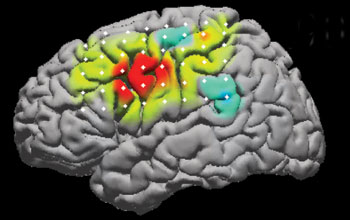Multimedia Gallery
Brain-controlled Cursor (Image 2)
Image shows brain activity after about 10 minutes of training, where a subject could hit a target with 94 percent accuracy. The signal was stronger than in an earlier trial, and even stronger than when the subject actually performed the imagined movement. The trial was part of research at the University of Washington (UW) on harnessing brain signals to control keyboards, robots or prosthetic devices.
Hooking a human brain up to a computer, researchers looked at signals on the brain's surface, while using imagined movements to control a cursor. The results showed that watching a cursor respond to one's thoughts prompts brain signals to become stronger than those generated in day-to-day life.
"Bodybuilders get muscles that are larger than normal by lifting weights," said Kai Miller, lead author of the published study and a UW doctoral student in physics, neuroscience and medicine. "We get brain activity that's larger than normal by interacting with brain-computer interfaces. By using these interfaces, patients create super-active populations of brain cells."
The finding holds promise for rehabilitating patients after stroke or other neurological damage, and suggests that a human brain could quickly become adept at manipulating an external device such as a computer interface or a prosthetic limb. To learn more, see UW news story "Brain-controlled cursor doubles as a neural workout." [Research funded in part by the National Science Foundation.] (Date of Image: 2009). [Image 2 of 2 related images. Back to Image 1.]
Credit: Kai Miller, University of Washington
Images and other media in the National Science Foundation Multimedia Gallery are available for use in print and electronic material by NSF employees, members of the media, university staff, teachers and the general public. All media in the gallery are intended for personal, educational and nonprofit/non-commercial use only.
Images credited to the National Science Foundation, a federal agency, are in the public domain. The images were created by employees of the United States Government as part of their official duties or prepared by contractors as "works for hire" for NSF. You may freely use NSF-credited images and, at your discretion, credit NSF with a "Courtesy: National Science Foundation" notation.
Additional information about general usage can be found in Conditions.
Also Available:
Download the high-resolution JPG version of the image. (1.1 MB)
Use your mouse to right-click (Mac users may need to Ctrl-click) the link above and choose the option that will save the file or target to your computer.



